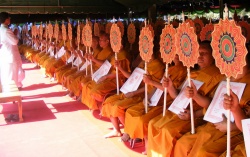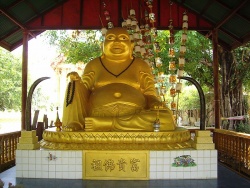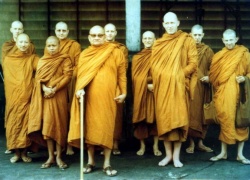Past, Present and Future Buddhism in Thailand by Dr. Sree Mattananda Sraman
People all over the world who are interested in Buddhism and keep in touch with its news and activities must have heard of the Buddha Jayanti celebrations held a few years ago in all Buddhist countries, including India and Japan. It was in 1957 or, according to the reckoning of some Buddhist countries, in 1956, that Buddhism, as founded by Gotama the Buddha, had completed its 2,500th year of existence. The Buddhist tradition, especially of the Theravada or Southern School such as now prevails in Burma, Ceylon, Cambodia, Laos and Thailand, has it that on the completion of 2,500 years from its foundation, Buddhism would undergo a great revival, resulting in its all-round progress, in both the fields of study and practice. Buddhists throughout the world, therefore, commemorated the occasion in 1956-57 by various kinds of activities such as meetings, symposia, exhibitions and the publication of Buddhist texts and literature.
As to whether or not the tradition mentioned above has any truth behind it, the future alone will testify. However, judging from news received from all corners of the globe, it is no exaggeration to say that mankind is taking an ever-increasing interest in Buddhism. As a matter of fact, since the end of the Second World War interest in Buddhism as evinced by people in Europe, America, and Australia has reached a scale unheard of before. Any casual perusal of journals on Buddhism in any of these continents will convince the readers of this statement. It is a matter worth noticing that after the end of the First World War also, Buddhism made great headway in Europe and elsewhere. This phenomenon can perhaps be best explained by the fact that mankind's spiritual thirst is more sharpened by calamities like war, and that in times of distress mankind realizes Truth better.
The Land of Yellow Robes
Thailand is perhaps the only country in the world where the king is constitutionally stipulated to be a Buddhist and the upholder of the Faith. For centuries Buddhism has established itself in Thailand and has enriched the lives of the Thais in all their aspects. Indeed, without Buddhism, Thailand would not be what it is today. Owing to the tremendous influence Buddhism exerts on the lives of its people, Thailand is called by many foreigners "The Land of Yellow Robes," for yellow robes are the garments of Buddhist monks. In view of the increasing interest the world is taking in Buddhism and in view of the fact that Thailand is one of the countries where Buddhism still exists as a living force it will not, perhaps, be out of place to know something of the story of how this great faith reached that country.
Buddhism in Thailand: It’s Past
Different opinions exist about when, exactly, Buddhism reached that part of the world now officially known as Thailand. Some scholars say that Buddhism was introduced to Thailand during the reign of Asoka, the great Indian emperor who sent Buddhist missionaries to various parts of the then known world. Others are of the view that Thailand received Buddhism much later. Judging from archaeological finds and other historical evidence, however, it is safe to say that Buddhism first reached Thailand when the country was inhabited by a racial stock of people known as the Mon-Khmer who then had their capital, Dvaravati, at a city now known as Nakon Pathom (Sanskrit: Nagara Prathama), about 50 kilometers to the west of Bangkok. The great pagoda at Nakon Pathom, Phra Pathom Chedi (Prathama cetiya), and other historical findings in other parts of the country testify to this fact as well as to the fact that Buddhism, in its varied forms, reached Thailand at four different periods, namely:
- Theravada or Southern Buddhism
- Mahayana or Northern Buddhism
- Burma (Pagan) Buddhism
- Ceylon (Lankavamsa) Buddhism
We shall now proceed to study each of these periods in detail.
I. Theravada or Southern Buddhism
That the first form of Buddhism introduced to Thailand was that of Theravada (The Doctrine of the Elders) School is proved by various archaeological remains unearthed in the excavations at Nakon Pathom, such as the Dharma Chakra (Wheel of Law), the Buddha footprints and seats, and the inscriptions in the Pali language, all of which are in rocks. Such objects of Buddhistic veneration existed in India before the introduction of the Buddha image, which appeared later as a result of Greek influence. Buddhism, therefore, must have reached Thailand during the 3rd century B.C., and it must have been more or less the same form of Buddhism as was propagated by the great Buddhist Emperor Asoka. This form of Buddhism was known as Theravada or Hinayana (The Lower Vehicle) in contradistinction to the term Mahayana (The Higher Vehicle); the two schools having sprung up soon after the passing away of the Buddha. When worship of the Buddha image became popular in India, it also spread to other countries where Buddhism had already been introduced. This is borne out by the fact that many Buddha images, especially those of the Gupta style, had been found in the ruins of Nakon Pathom and the neighboring cities. Judging from the style of the Buddha images found, it can also be assumed that the early Buddhist missionaries to Thailand went from Magadha (in Bihar state, India).
To support the view that the first form of Buddhism introduced to Thailand was that of the Theravada School as propagated by Emperor Asoka, we have evidence from the Mahavamsa, the ancient chronicle of Ceylon. In one of its passages dealing with the propagation of the Dhamma, the Mahavamsa records that Asoka sent missionaries headed by Buddhist elders to as many as nine territories. One of these territories was known as Suvarnabhumi where two Theras (elder monks), Sona and Uttara, were said to have proceeded.
Now opinions differ as to where exactly this land of Suvarnabhumi is. Thai scholars express the opinion that it is in Thailand and that its capital was at Nakon Pathom, while scholars of Burma say that Suvarnabhumi is in Burma, the capital being at Thaton, a Mon (Peguan) town in eastern Burma near the Gulf of Martaban. Still other scholars of Laos and Cambodia claim that the territory of Suvarnabhumi is in their lands. Historical records in this connection being meager as they are, it would perhaps be of no avail to argue as to the exact demarcation of Suvarnabhumi. Taking all points into consideration, one thing, however, seems clear beyond dispute. That is Suvarnabhumi was a term broadly used in ancient times to denote that part of Southeast Asia which now includes Southern Burma, Thailand, Laos, Cambodia and Malaya. The term Suvarnabhumi is a combination of the words suvarna and bhumi. Both are Sanskrit words; the former means gold and the latter stands for land. Suvarnabhumi therefore literally means Golden Land or Land of Gold. Keeping in view the abundance of nature in that part of Asia just referred to, the term seems but appropriate.
The reason why scholars of Thailand express the view that the capital of Suvarnabhumi was at Nakon Pathom was because of the archaeological finds unearthed in the area surrounding that town. Nowhere in any of the countries mentioned above, not even at Thaton in Burma, could one find such a large and varied number of ancient relics as were found at Nakon Pathom. By age and style these archaeological objects belong to the times of Emperor Asoka and the later Guptas. Even the Great Stupa (Phra Pathom Chedi) at Nakon Pathom itself is basically identical with the famous Sañchi Stupa in India, built by Asoka, especially if one were to remove the shikhara or upper portion. Many Thai archaeologists are of the opinion that the shikhara was a later addition to the pagoda, a result, so to say, of the blending of the Thai aesthetic sense with Indian architectural art. Moreover, the name Pathom Chedi (Pali: Pathama Cetiya) means "First Pagoda" which, in all probability, signifies that it was the first pagoda built in Suvarnabhumi. This would easily fit in with the record of the Mahavamsa — that Theras Sona and Uttara went and established Buddhism in the territory of Suvarnabhumi at the injunction of Emperor Asoka. Taking cognizance of the fact that Asoka reigned from 269 to 237 B.C., we can reasonably conclude that Buddhism first spread to Thailand during the 3rd century B.C. It is interesting to note in this connection that the history of the penetration of Indian culture to Southeast Asia also started more or less during the same period.
II. Mahayana or Northern Buddhism
With the growth of Mahayana Buddhism in India, especially during the reign of King Kanishka who ruled over Northern India during the second half of the first century A.D., the sect also spread to the neighboring countries, such as Sumatra, Java, and Kambuja (Cambodia). It is probable that Mahayana Buddhism was introduced to Burma, Pegu (Lower Burma) and Dvaravati (now Nakon Pathom in Western Thailand) from Magadha (in Bihar, India) at the same time as it went to the Malay Archipelago. But probably it did not have any stronghold there at that time; hence no spectacular trace was left of it. Starting from the beginning of the fifth century A.D. Mahayana Buddhist missionaries from Kashmir in Northern India began to go to Sumatra in succession. From Sumatra the faith spread to Java and Cambodia. By about 757 A.D. (Buddhist Era: 1300) the Srivijaya king with his capital in Sumatra rose in power and his empire spread throughout the Malay Peninsula and Archipelago. Part of South Thailand (from Surasthani downwards) came under the rule of the Srivijaya king. Being Mahayanists, the rulers of Srivijaya gave much encouragement and support to the propagation of Mahayana Buddhism. In South Thailand today we have much evidence to substantiate that Mahayana Buddhism was once prevalent there. This evidence is in the form of stupas or chetiyas and images, including votive tablets of the Buddhas and Bodhisattas (Phra Phim), which were found in large number, all of the same type as those discovered in Java and Sumatra. The chetiyas in Chaiya (Jaya) and Nakon Sri Thammarath (Nagara Sri Dharmaraja), both in South Thailand, clearly indicate Mahayana influence. From 1002 to 1182 A.D. kings belonging to the Suryavarman dynasty ruled supreme in Cambodia. Their empire extended over the whole of present-day Thailand. Being adherents of Mahayana Buddhism with a strong mixture of Brahmanism, the Suryavarman rulers did much to propagate and establish the tenets of the Northern School. There is an interesting stone inscription, now preserved in the National Museum at Bangkok, which tells us that in about 1017 A.D. (B.E. 1550) there ruled in Lopburi, in central Thailand and once a capital city, a king from Nakon Sri Thammarath who traced his ancestry to Srivijaya rulers. The king had a son who later became the ruler of Kambuja (Cambodia) and who, more or less, kept Thailand under the suzerainty of Cambodia for a long time. During this period there was much amalgamation of the two countries' religions and cultures. The stone inscription under consideration probably refers to one of the Suryavarman kings who had blood relationship with the Srivijaya rulers.
From the inscription just referred to we also learn that at that period the form of Buddhism prevalent in Lopburi was that of Theravada, and that Mahayana Buddhism, already established in Cambodia, became popularized in Thailand only after Thailand had come under the sway of Cambodia. There are no indications, however, that the Mahayana School superseded the Theravada in any way. This was due to the fact that Theravada Buddhism was already on a firm basis in Thailand when the Mahayana School was introduced there. That there were monks of both schools, Theravada and Mahayana, in Lopburi during those days, is indicated in a stone inscription in the Cambodian language, found in a Brahmanic Temple within the vicinity of Lopburi city itself.
Much of the Brahmanic culture which survives in Thailand till today could be traced to its origin from Cambodia during this period. Many of the Cambodian kings themselves were zealous adherents of Brahmanism and its ways of life. This period, therefore, can be termed Mahayana Period. Sanskrit, the sacred language of the Hindus, took its root deep in Thailand.
Source
Author: Dr. Sree Mattananda Sraman
buddhismandaustralia.com



